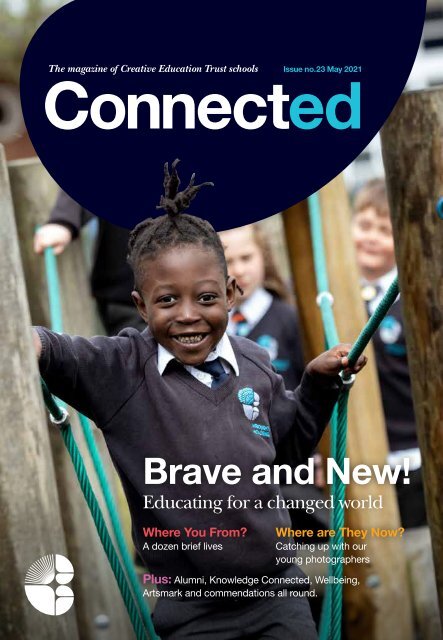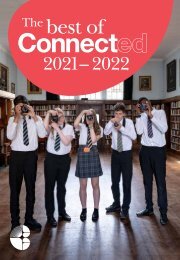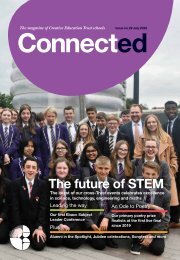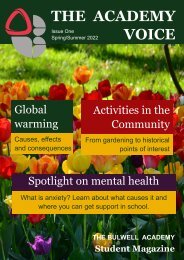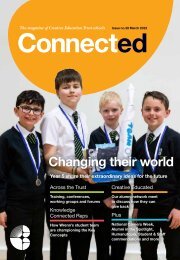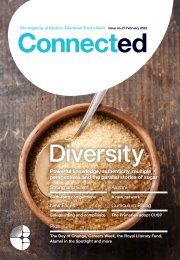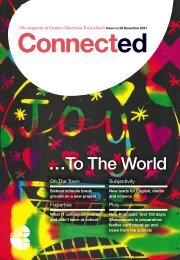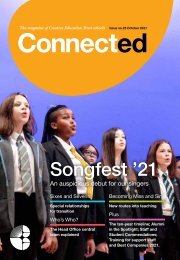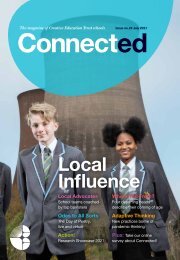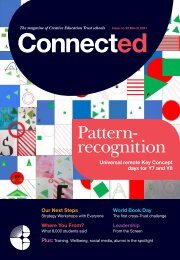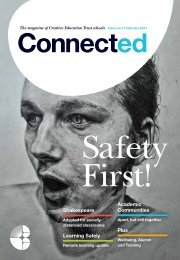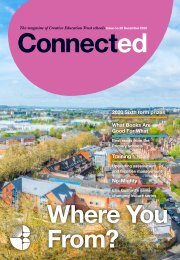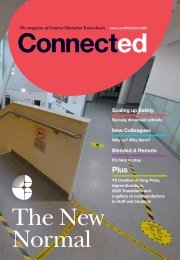Connected issue 23
The 23rd issue of Connected: the magazine of Creative Education Trust schools
The 23rd issue of Connected: the magazine of Creative Education Trust schools
Create successful ePaper yourself
Turn your PDF publications into a flip-book with our unique Google optimized e-Paper software.
The magazine of Creative Education Trust schools Issue no.<strong>23</strong> May 2021<br />
<strong>Connected</strong><br />
Brave and New!<br />
Educating for a changed world<br />
Where You From?<br />
A dozen brief lives<br />
Where are They Now?<br />
Catching up with our<br />
young photographers<br />
Plus: Alumni, Knowledge <strong>Connected</strong>, Wellbeing,<br />
Artsmark and commendations all round.
<strong>Connected</strong><br />
Issue no.<strong>23</strong><br />
02 03<br />
The magazine of Creative Education Trust schools<br />
May 2021<br />
Brief<br />
Lives<br />
Ngog Tan, Recently Qualified Teacher<br />
of Mathematics, Ellis Guilford<br />
In Vietnam my mother worked with a brave face through<br />
her unhappy marriage to pay the bills, put food on the<br />
table and get us into the best schools. When I was 13 she<br />
decided to seek a better future in the UK. Mathematics<br />
was my passion, and after graduating with an MBSc from<br />
Nottingham I worked as an analyst, but I struggled to find<br />
satisfaction. Curiosity took me to a Teach First event, which<br />
touched me deeply because I knew how hard it is to break<br />
the cycle of poverty. I quit to start my teaching career and<br />
am now completing my RQT.<br />
Susan Tarr, Cover Supervisor,<br />
Queen Eleanor<br />
My early adult years were in security services in Great<br />
Britain and Germany – as an arms and bomb searcher in<br />
Northern Island, wall patrol in Berlin, a guard at Spandau<br />
prison, a UK prison officer and a protection officer for<br />
members of the royal family. I came home to Northampton<br />
to be a paediatric assistant, and then, after adopting<br />
the first of my 3 boys, I became a primary school TA.<br />
I completed my teaching and learning degree to equip<br />
me better in leading young people down the right path.<br />
Isaac Howarth, Head Teacher,<br />
Queen Eleanor<br />
Where You From? <strong>Connected</strong> put out a call to<br />
staff: “Describe how you got from the place you<br />
were born to the job you do today in 75 words or<br />
fewer, explaining what motivated the transitions.”<br />
We expect readers will overlook some liberties<br />
with the word count, because a dozen colleagues<br />
have responded with brief lives that display the<br />
magnificent array of cultural knowledge, training,<br />
experience and evolving professional vocation<br />
that drives staff in their daily work today.<br />
I was born in Kitchener, Canada,<br />
and grew up in the Niagara region<br />
of Ontario. I left for university with a<br />
constant curiosity about the world and<br />
the daily life of different people. It’s<br />
driven my working life in historic sites,<br />
social care services and education.<br />
Opportunities to try something different,<br />
to get lost and find my way across<br />
unfamiliar terrain (both geographical<br />
and professional) have landed me – via<br />
villages, towns and cities – to where I<br />
am now.<br />
Serena Trkulja,<br />
Teacher of Drama, Wrenn<br />
Malika Steed,<br />
Teacher of Geography, Lynn Grove<br />
I grew up in Alsace and completed a degree in<br />
Strasbourg because I was considering a career<br />
at the UN. A teacher-training scholarship from<br />
the Royal Geographical Society brought me to<br />
the UK where I met my husband as a young<br />
professional, and I moved to England to be with<br />
him. My Berber ancestry originates in the Aures<br />
Mountains of North Africa. With incredible pride<br />
in this rich global heritage, I have always been<br />
a Geographer.<br />
Ruth Wood, Head of MFL, Caister<br />
I love talking to people, and languages were a way not only to talk to more<br />
people, but also to eavesdrop more effectively! I was born in Swansea and<br />
grew up in Hertfordshire. I read German at UEA and loved my year abroad in<br />
Bavaria, so I took a job in internal distribution at Jeyes to use my German and<br />
travel abroad. But I also love Norfolk, so when teaching called I went back to<br />
UEA, thence to a languages reaching post in Suffolk, and now Caister.<br />
During my childhood I had a passion for<br />
how drama can draw you into a different<br />
world. As a university Drama student I<br />
taught children aged 5-12 at weekends, and<br />
this is where my love for teaching began.<br />
But I still wanted to see the world, so I used<br />
my drama skills to entertain children on<br />
cruise ships. On those travels I picked up<br />
techniques that different cultures use – for<br />
example using drama to show right from<br />
wrong, or as an escape from real life.<br />
Wayne Mernagh,<br />
Head of Humanities,<br />
Milton Keynes<br />
Milton Keynes Academy<br />
stands on the site of the<br />
school where I completed<br />
my secondary education in the 1980s. Thanks to the<br />
commitment and encouragement of certain teachers I left it<br />
to complete my degree at Lancaster University. And thanks<br />
to a chance meeting in a local pub I was invited back to<br />
interview for a job as a history teacher. 28 years on I still<br />
enjoy the community that gave me my education, career<br />
and family – and is my home.<br />
Jeremy Burrows,<br />
Teacher of Mathematics, Wrenn<br />
Mathematics has been my passion from the moment I first<br />
picked up a pencil. Wanting to dedicate my life to helping<br />
others, I studied to be a lawyer, but after 25 years as a<br />
practising solicitor, I felt something was missing. I wasn’t<br />
making a direct contribution to the future of the next<br />
generation. Teaching mathematics was the answer, and<br />
after taking early retirement and re-training I feel much more<br />
fulfilled and happier with life.
04<br />
<strong>Connected</strong><br />
The magazine of Creative Education Trust schools<br />
Issue no.<strong>23</strong><br />
May 2021<br />
05<br />
Carolina Vettese,<br />
Head of MFL, Lynn Grove<br />
On my tenth birthday I arrived in Great<br />
Yarmouth from my beloved Argentina<br />
with no English. My father had joined the<br />
large offshore workers’ community of the<br />
1980s and we were starting a new life. My<br />
greatest affinity as a teacher now is with the<br />
immigrant pupils. My brothers and I started<br />
school with the English/Spanish dictionary as<br />
our constant accessory, and England gave<br />
us an excellent education. We should never<br />
underestimate the importance of learning<br />
another language.<br />
Imogen Simpson,<br />
Teacher of English,<br />
Ellis Guilford<br />
I grew up in the privileged South East,<br />
while being very working class. I chose to<br />
move to the Midlands for University and<br />
fell in love with the welcoming people and<br />
beautiful landscapes. My plan had been<br />
to relocate to Wales after training, but I<br />
met my husband instead! He inspired me<br />
to continue working in Inner City schools<br />
with his own experience of being left<br />
behind in education.<br />
Kevin Cromwell,<br />
Head of Geography, Caister<br />
Alex Harrison, Teaching<br />
Assistant, Ellis Guilford<br />
I was raised in Burton-on-Trent,<br />
Staffordshire and deferred my uni<br />
place for a year to volunteer in Africa.<br />
Although I came back older, wiser<br />
and readier for university, health<br />
problems forced me to leave before<br />
finishing my degree. At a loose end,<br />
I started volunteering as a classroom<br />
TA and found I loved working with<br />
students with additional needs. I<br />
got a job at Ellis in 2008, completed<br />
my degree through the Open<br />
University and worked my way up to<br />
Level 4, leading on science for the<br />
Accelerated Learning Gateway.<br />
I could never have planned or predicted my journey from<br />
Huddersfield to Caister-on-Sea. I’m proud of my workingclass,<br />
northern heritage and I've always been inspired<br />
by the Rochdale Pioneers who founded the co-operative<br />
movement. Two of their values in particular – solidarity and<br />
caring for others – led me to become a police officer in Greater<br />
Manchester in my early twenties. In the end, I moved into a<br />
profession (teaching) where the onus was pro-action, rather<br />
than re-action. I'll never forget where I came from, and if I can<br />
inspire just one student to take a different path then it was well<br />
worth the change of career.<br />
Gabi Willis, Head of Geography,<br />
Milton Keynes<br />
My parents couldn’t afford to send me<br />
to university so I qualified as teacher via<br />
correspondence as a married mother-of-two<br />
working as an administrator in a school. I was<br />
a geography teacher in Johannesburg by the<br />
time an unexpected phone call changed my<br />
life and gave me 10 weeks to wrap up and<br />
move across the world to a teaching post in<br />
the UK. It’s been a huge learning curve and<br />
I’ve really needed an open mind – not only<br />
does the profession have a different status<br />
here, but what worked in an all-boys school in<br />
South Africa does not work at Milton Keynes!<br />
Knowledge<br />
<strong>Connected</strong><br />
Y7<br />
Meaning<br />
In a special off-timetable day planned by<br />
Knowledge <strong>Connected</strong> Academic Community,<br />
Year 7 students have been learning how meaning<br />
resides in images, objects and places as well<br />
as in words. The day’s activities were written to<br />
help students learn to interrogate, challenge and<br />
manipulate meaning.<br />
Y8<br />
Human Interaction<br />
Year 8 students headed off to their usual lessons, but explored Human<br />
Interaction in every timetabled subject through exercises in trust, cooperation,<br />
empathy, persuasion and collaboration. The examples below<br />
are from Year 8 Abbeyfield students, who were encouraged to think about<br />
the influence of human behaviour, and its occasional unpredictability.<br />
Geography<br />
Learning Objective:<br />
I can influence a decision as<br />
part of a group.<br />
In this lesson students learn about<br />
the viewpoints and experiences which<br />
factor into international decisions on<br />
climate change. In a process evoking<br />
UN negotiations, groups of students<br />
representing countries develop<br />
arguments to back their positions on<br />
reducing carbon emissions. They also<br />
decide on their willingness to negotiate,<br />
before a spokesperson presents back<br />
to the class.<br />
Last term’s days of Pattern<br />
were remote for Years 7<br />
and 8, but now Knowledge<br />
<strong>Connected</strong> is back in school,<br />
helping students connect their<br />
knowledge and skills across the<br />
curriculum. Here’s a taster of<br />
what our pupils experienced.<br />
Change the meaning of an object<br />
This drawing exercise starts with students exploring the meaning in an object<br />
by listing its features and qualities. The drawings below show students’ ideas<br />
of what the same object might be like if it had the opposite meaning to the<br />
one in the photograph.<br />
Students said:<br />
“As<br />
representatives<br />
of India, we think climate<br />
change is now our biggest<br />
<strong>issue</strong>. Our country is<br />
industrialising very quickly,<br />
which, although it is making<br />
us richer, is giving out more<br />
carbon emissions. We’re very<br />
big country with 1 billion<br />
people living here, meaning<br />
we have lots of poverty. We<br />
do NOT want to cut our<br />
carbon emissions.”<br />
Students said:<br />
“As the UK, we<br />
acknowledge<br />
that we have high carbon<br />
emissions, but we plan to cut<br />
these by 80% by 2050. We<br />
feel strong that climate change<br />
is going to impact our lives<br />
negatively and we would<br />
like all countries to cut down<br />
their carbon emissions. We<br />
appreciate that less fortunate<br />
countries may not be able to do<br />
this, but we offer our support.”
06<br />
<strong>Connected</strong><br />
The magazine of Creative Education Trust schools<br />
Issue no.<strong>23</strong><br />
May 2021<br />
07<br />
Religious Studies<br />
Learning objective:<br />
I understand the role of empathy<br />
in positive social change.<br />
The rationale behind this lesson is that<br />
human interaction across cultural,<br />
religious and international boundaries<br />
is possible if we empathise and respect<br />
difference. Students learn Malala<br />
Yousafzai’s story, watch her 2013<br />
speech to the UN, and analyse what<br />
it was that made everyone listen.<br />
BRAVE<br />
Malala Yousafzai (GPE/Sarah Beeching)<br />
NEWWORLD<br />
English<br />
Learning objective:<br />
I can identify and explain how<br />
books can influence society.<br />
Looking at passages from classic<br />
books that have been banned, students<br />
consider why people in the past may<br />
have thought these texts dangerous or<br />
detrimental to society. They discussed<br />
age inappropriateness, political bias,<br />
religious affiliation, and the inclusion of<br />
witchcraft or violence.<br />
The political<br />
satire Animal<br />
Farm was<br />
banned in the<br />
USSR when it<br />
was published in<br />
1945. The book<br />
was also<br />
forbidden in a<br />
range of schools<br />
across the US,<br />
and today it<br />
continues to be banned in the United<br />
Arab Emirates where it’s deemed to<br />
conflict with Islamic values. Why?<br />
Students said:<br />
Originally published in 1900, the<br />
Wizard of Oz by L.Frank Baum was<br />
later banned from a number of<br />
libraries in the US. Concerns about<br />
the book included giving animals<br />
human characteristics, having a<br />
strong female lead, and suggesting<br />
it was possible for a ‘good witch’<br />
to exist. Students said:<br />
“There’s political meaning as the animals were<br />
written to represent what was happening to<br />
people in Russia at the time. There is also<br />
violence and negativity in the deaths of<br />
animals.”<br />
Harry Potter and the<br />
Goblet of Fire was<br />
banned in several<br />
schools in the US<br />
after its publication<br />
in 2000. The book<br />
was seen to make<br />
witchcraft and wizarding alluring<br />
to children by presenting magic as both good<br />
and evil. The Harry Potter series was also banned<br />
in schools across the United Arab Emirates due<br />
to the presence of witchcraft. Students said:<br />
“Because of a ‘childlike’ being coming out of the<br />
cauldron, which is associated with witchcraft. It could<br />
also be seen as age inappropriate as it’s kind of scary<br />
for a younger child.”<br />
“Because of<br />
the violence<br />
and<br />
negativity<br />
(the<br />
mentions of beatings).<br />
Also because the winged<br />
monkey and golden<br />
cap are examples of<br />
witchcraft.”<br />
The Covid pandemic caused every industry, organisation and sector, every country<br />
and community, to make dramatic changes in the way we go about our daily<br />
business and plan ahead. The same is true for almost every individual, almost<br />
everywhere in the world. Certain things we took for granted in the old world order –<br />
whether good or bad – have dissolved in the new, and we have an opportunity to do<br />
things differently. <strong>Connected</strong> invited ten leading figures in professional spheres that<br />
touch us all to tell us what we can look forward to. Our task is to educate children<br />
for the brave new world they describe.<br />
Community: Measuring<br />
the Unmeasurable<br />
Chris Brown is the founder of Igloo Regeneration, described by<br />
the UN as “the world’s first responsible real estate fund”. Igloo<br />
unites community-led property development around the UK<br />
with sustainable investment by working with local authorities,<br />
trade associations, development agencies, financial institutions,<br />
architects and other technologists.
08<br />
Over the last year we’ve seen a blaze of community activity,<br />
an outpouring of mutual aid, neighbours helping neighbours,<br />
lit by the spark of Covid kindness. This has highlighted the<br />
importance of community. It’s not enough for housebuilders<br />
to deliver housing numbers, we have to build communities.<br />
Community action can prevent loneliness, improve health,<br />
combat the Climate Emergency, support kids growing up<br />
(“It takes a village to raise a child”) and so much more.<br />
But how do we know how strong the community is?<br />
And how best we can help?<br />
Through the pandemic we’ve been working with<br />
Transformational Index, who invent ways for charities, social<br />
enterprises and training initiatives to measure things that are<br />
hard to measure, and with Nationwide, the world’s largest<br />
building society. We developed a method, using Office<br />
of National Statistics standards, to measure community<br />
strength to help us work out what works to<br />
help build community.<br />
Two things that help are community organisers and<br />
community funds. At Oakfield, a new community in<br />
Swindon, the community organiser, Keith Brown, spent<br />
time meeting and listening to local people, long before<br />
the plans were drawn, and then he got on and organised.<br />
Our projects have community funds to ensure that<br />
community groups have the money to do the activities<br />
that bring people together.<br />
This community building is not new – the urban planner<br />
Ebenezer Howard was doing it more than a century ago<br />
to encourage clubs and societies in the prototype garden<br />
city of Letchworth – and the benefits continue there today.<br />
But Covid has reminded us starkly of the importance of<br />
connecting the people that live in the houses and places we<br />
build. We need to apply it in every new neighbourhood the<br />
industry builds so that the legacy we create is all the good<br />
that flows from stronger communities.<br />
Technology:<br />
What Problem?<br />
Didem Un Ates, non-Executive Director of Creative<br />
Education Trust, has spent her management career at<br />
the intersection of business and technology. ‘Artificial<br />
Intelligence’, or AI (computer systems able to perform<br />
tasks that normally require human intelligence) is<br />
already with us and it’s not science fiction. Only by<br />
growing their digital skills, she urges, can individuals<br />
direct its use and purpose to positive ends.<br />
During an AI event that I attended last July, thought<br />
provoking questions about the future of work came up.<br />
What had triggered AI to take off at such scale, all of a<br />
sudden? What do the latest AI trends suggest about the<br />
future of work? What impact will COVID have? Just<br />
as good citizens in a democracy need to protect the<br />
democracy for which they will bear the consequences,<br />
we all need to upskill ourselves in technology so that<br />
we can better manage the risks it brings.<br />
However distantly, most of us are aware that cloud<br />
technology, the accumulation of massive amounts of data,<br />
and innovations in machine learning have infused every<br />
industry and function with AI. Machines and robots become<br />
more competent all the time at using their ‘senses’ to imitate<br />
the human brain – from its vision, speech recognition, reading<br />
and comprehension to dialogue and context-awareness.<br />
Combined with other powerful technologies, these<br />
improvements enable us to solve almost any problem.<br />
As such, clear goals on what opportunity or problem we<br />
want to pursue with AI – as individuals and organizations<br />
– are imperative.<br />
Although studies show that over half of today’s students will<br />
do jobs that don’t yet exist, and that this year alone over 8m<br />
individuals will need new skills to do the jobs they already<br />
have, workforce trends are at odds with the ambitions of the<br />
tech world. Talent, diversity, moral purpose and intransigent<br />
formal structures struggle to keep pace with the rapid<br />
transformation of work. Already most researchers agree that<br />
around 50 percent of jobs are automated, and moreover,<br />
that 90 percent of the human jobs remaining – or any newly<br />
created job – will require tech skills. Both Accenture and<br />
Microsoft (my former and current employers) have launched<br />
vast-scale digital skills programmes in the UK and around the<br />
world, recognising that we will only bridge this discrepancy<br />
by continuous digital upskilling.<br />
I was asked a year ago ‘What happens to all this after the<br />
COVID crisis?’ The answer is that ‘all this’ has accelerated<br />
our tech adoption like no one imagined – some estimate<br />
by ten years. The answers to other questions about future<br />
jobs and skills are less clear. I recommend an outstanding<br />
book called Human + Machine, whose authors suggest<br />
three clusters of jobs that will fill a ‘missing middle’ between<br />
humans and machines: Trainer, Explainer and Sustainer.<br />
As for skills, I would pick three from the top ten Bernard Marr<br />
listed in an article for Forbes last year: creativity, collaboration<br />
and cultural diversity. A diversity of voices working together<br />
with no preconceived solution to name the problems and the<br />
opportunity for AI to address.<br />
#<br />
Music: Good News for<br />
the Individual Player<br />
Julian Joseph, virtuoso jazz pianist, composer and<br />
broadcaster, is also the founder of the eponymous<br />
jazz academy for teenage musicians. When<br />
experiencing live music still seems remote, what<br />
comfort can we take?<br />
“We all need to upskill<br />
ourselves in technology so<br />
that we can better manage<br />
the risks it brings.”<br />
Because performance has started to be less genre-bound,<br />
musical training already incorporates a wide-range of<br />
tutelage, including jazz and folk music alongside classical,<br />
pop and technological media. All these give music-makers<br />
greater awareness of the riches and value a myriad of<br />
cultures have to offer. This ought to help birth musicians<br />
into a more accepting and open sense of limitless creation.<br />
What a wonderful future for music that would be! In the<br />
meantime, the pandemic has confirmed how adaptable we<br />
are; how ready to use the available technologies. Zoom<br />
has been interesting for us at the Academy because, for<br />
all of its shortcomings, it does offer real opportunities to<br />
highlight and support individuals in a group. Listening<br />
to individuals becomes the more workable option when<br />
hearing everything together still has real technological<br />
limitations. Hopefully the engineers now have the impetus<br />
to develop a viable accommodation for ensemble playing<br />
over the internet.<br />
Issue no.<strong>23</strong><br />
May 2021<br />
Hospitality:<br />
Changing the Pace<br />
Alex Bond is the owner-chef of one of the UK’s<br />
great restaurants, the Michelin-starred Alchemilla in<br />
Nottingham, and a winning chef of Great British Menu<br />
2021. This year Bond created a set of four recipes to feed<br />
a family of four with supermarket ingredients costing no<br />
more than £15 especially for Creative Education Trust.<br />
As we re-open our doors again, I actually feel the industry<br />
as a whole is stronger. Restaurant-quality takeaways<br />
have proven popular and customers have now come to<br />
expect more. Plenty of restaurants I know will continue to<br />
do them – it’s a positive stream of income that won't be<br />
affected in the event of another lockdown. As for our own<br />
restaurant, Alchemilla, whilst our meal boxes have proved<br />
popular, the style of food wasn't authentically ‘Alchemilla<br />
restaurant’ so we won't continue to do them, but our bottled<br />
cocktails are something that we hope to take nationwide.<br />
The cocktails allow us to work from the same premise as<br />
our food offering – we take ingredients to new heights using<br />
innovative techniques. We'll also go back to a service that we<br />
experimented with when the curfew was in place, and that<br />
we found worked both for us and for diners: two sittings per<br />
night and an additional lunch service on a Saturday. It means<br />
diners are able to enjoy the whole experience at a more<br />
leisurely pace and our staff benefit from reasonable finishing<br />
times of an evening. Every restaurant will face inevitable<br />
changes and new features in order to survive.<br />
It's now a new way of working.<br />
+<br />
09
<strong>Connected</strong><br />
Issue no.<strong>23</strong><br />
10 11<br />
The magazine of Creative Education Trust schools<br />
May 2021<br />
Museums: The Benefits<br />
of Enforced Improvisation<br />
Josephine Chanter, Director of Audiences at London’s Design<br />
Museum, describes the surprising expansion of audience reach<br />
and engagement that came to many museums as a result of<br />
shutting their doors to the public.<br />
When the Design Museum shut its doors to the public in March 2020, we<br />
shifted our sights immediately to the possibilities of a digital programme.<br />
Not just my Audiences team, but everyone – Curatorial, Learning,<br />
Collections and Communications too. As happens in many organisations,<br />
there’d been a recurring conversation about how we must all work more<br />
and better together, which always seemed to end with everyone resolving<br />
anew to continue doing what they separately do! But the pandemic made<br />
everyone suddenly think ‘We need to do something really different.” There<br />
was a week of throwing ideas around, driven by deadlines and a raw, new<br />
question about everything we do: ‘if everything’s up in the air what can this<br />
look like?’ The different teams had to work together to deliver anything.<br />
Having a meeting just didn’t cut it any more as an indication of progress.<br />
This intensely collaborative way of working also translated into our<br />
response to the BLM movement later that Summer. Teams worked<br />
together to craft a response for something that, three months earlier,<br />
would have just been allocated to Comms. And it continues – in March<br />
2021 we re-opened our shop to project the message that creativity is an<br />
essential part of being human and should be accessible to everyone.<br />
The Supermarket (pictured) was stocked with essential items packaged<br />
in artworks created by emerging artists – tins of beans, tea, coffee,<br />
bread, pasta sauce, porridge oats, rice, toilet paper and washing up liquid.<br />
The proceeds went to our emerging artists access fund.<br />
The urgency of our response to lockdown was completely embedded in<br />
curatorial content, learning programmes and audience strategy, with each<br />
perspective feeding into a richer response. It felt like an opportunity to<br />
experiment, to try different things and find out what people respond to and<br />
really want from the Museum. By creating and sharing more content, we<br />
started to get compliments on expressing more personality. And people<br />
were asking us ‘can we get involved?’ – always a good sign. What started<br />
as an enforced improvisation a year ago has shifted us into a different<br />
groove today.<br />
Employment:<br />
Good Work, Still<br />
Matthew Taylor, appointed as the new<br />
chief executive of the NHS Federation,<br />
wrote a report on modern working<br />
practices for the government in 2017<br />
entitled Good Work and looked back<br />
at it during the Covid crisis. However<br />
scarce as a result of pandemic lockdown,<br />
wherever performed, accomplished with<br />
whatever degree of technological means,<br />
he reminds us that quality is paramount.<br />
Even before the crisis there was beginning to be<br />
discussion in Whitehall of the need for a labour<br />
market strategy – a strategy wide enough to<br />
encompass welfare and tertiary education as well as<br />
paid employment. Now, the scale of unemployment,<br />
the acceleration of technological take-up, and<br />
public concern about precarious work all add to the<br />
necessity for a concerted approach to labour. Some<br />
of the shifts in patterns of work that have occurred<br />
in the crisis may persist and ideas like the shorter<br />
working week and universal basic income (UBI) are<br />
becoming more mainstream.<br />
In my 2017 report to the government, Good<br />
Work, I gave five reasons why good work matters:<br />
because everybody needs progress routes in work;<br />
because high quality work helps people stay healthy<br />
and happy; because it’s also a means of tackling<br />
low productivity; because our civic aspiration is<br />
to feel respected, trusted and enabled to take<br />
responsibility; and because the pace of change<br />
(in the economy, in business and especially in<br />
technology) needs a fast, concerted response<br />
that’s also fair.<br />
The jobs focus after the crisis is likely to be on<br />
quantity of work as much as quality, but the reasons<br />
good work matters are even more salient today.<br />
»<br />
Transport:<br />
That First and Last Mile<br />
Kirsty Dias is a director of the international design firm<br />
Priestman Goode, specialists in transportation, and a<br />
member of the Education Standards Committee for<br />
Creative Education Trust. She envisages the public transport<br />
of the future as human-centered and planet-conscious as<br />
well as hygienically safe.<br />
Before the pandemic brought the world to a halt, much of the future<br />
thinking around planning, architecture and design focused on the<br />
growth of city living all over the world.<br />
Putting aside the need for reassurance about hygiene – which (for us<br />
as transport designers) has resulted in looking at how new materials<br />
and technologies can make journeys safer for everyone – the other<br />
major change brought about by the pandemic is that people are<br />
moving away from cities to more suburban and rural areas. With<br />
more people working from home – and the prediction is that this will<br />
continue – the need to be in bustling cities has lessened.<br />
The problem known as the ‘first and last mile’, has always been<br />
one of the hardest to solve in public transport. It refers to the way in<br />
which passengers get from their home to their mode of transport, and<br />
from that to their final destination. PriestmanGoode, the international<br />
design company where I’m a director, has been interested in it for<br />
some time, designing a “Scooter for Life” for older people and “Walk<br />
Lines” to encourage making more physically active choices. In a world<br />
that desperately needs to lower emissions, we have to find ways to<br />
encourage people to use public modes of transport over their own<br />
cars, but it can be difficult in towns and villages where those services<br />
may be lacking or infrequent.<br />
PriestmanGoode is working with Dromos Technologies on an<br />
Autonomous Transit Network, to address the first and last mile<br />
problem. It’s a network of electric autonomous vehicles that run on<br />
dedicated lanes (pictured), rather than mixed with existing traffic, and<br />
it allows you to travel directly from start to destination without having<br />
to stop on the way. It’s faster and more convenient for passengers,<br />
and suited to many different needs: from families to single travellers,<br />
passengers in wheelchairs or those with luggage or large items. While<br />
it’s early days, the response we’ve had is very promising and could be<br />
transformational for cities, towns and regional areas.
12<br />
<strong>Connected</strong><br />
The magazine of Creative Education Trust schools<br />
Theatre:<br />
Virtual Theatre-Goers,<br />
Young and Old<br />
— —<br />
—<br />
13<br />
Dale Rooks, Director of Learning, Education and Participation at Chichester<br />
Festival Theatre, tells how digital capability and live-streaming have<br />
redoubled the scale and quality of what the theatre is able to put out to the<br />
community.<br />
In 2020, Chichester Festival Theatre was forced to think creatively about how to stay<br />
connected with audiences while our theatres were closed and in-person events were<br />
cancelled. The challenges of the pandemic led us to experiment and innovate to<br />
produce online content and accelerated our digital knowledge, capability and learning.<br />
It helped us connect with new and diverse audiences, including significantly more<br />
young people, while maintaining vital contact with existing ones.<br />
Working closely with external partners, we delivered a total of 28 streamed<br />
performances and events, reaching over 153,000 people across 52 countries. Our<br />
online community activities engaged with a further 156,000. In October 2020, a new<br />
production of Sarah Kane’s Crave was scheduled to play to a live, socially distanced<br />
audience in the Festival Theatre while being simultaneously live-streamed to global<br />
digital audiences. When the run of live performances was interrupted by the second<br />
lockdown, the actors continued to perform for the cameras behind closed doors<br />
(pictured).<br />
Digital enabled us to stay connected to our community during 2020 and whilst a digital<br />
platform should not completely replace how we offer this work, we have learned that<br />
it is possible to achieve rewarding experiences virtually. In 2020, our Elders Company<br />
met on Zoom to rehearse and perform their writing; Chichester Festival Youth Theatre<br />
members produced online videos for care homes.<br />
We’ll continue to place live streaming at the centre of our plans for 2021, which<br />
also include a digital Festiv-ALL, working with local organisations to celebrate the<br />
achievements of 80 young people with additional needs. We will connect with schools<br />
to offer a bespoke digital resource giving students direct access to actors to enhance<br />
academic learning, and offer interactive opportunities to audiences of all ages and<br />
backgrounds.<br />
“We’ve had to carve<br />
out some smaller, extra<br />
spaces from the prescribed<br />
housing areas people<br />
can work undisturbed<br />
from home.”<br />
Housing:<br />
A Door to the Street<br />
Annalie Riches is a founding director the architectural<br />
practice Mikhail Riches, whose high-density, urban<br />
social housing in Norwich (pictured) won the UK’s<br />
biggest prize, the Stirling Prize, in 2019. What new<br />
dimension has the pandemic brought to their mission<br />
‘to create buildings people love’?<br />
The client (the property developer) is not an ‘end user’<br />
of housing – the client won’t be living there! We research<br />
intensively what makes a good home by asking the people<br />
we’re designing houses for directly. Sometimes it’s mundane<br />
features like bin stores and electrical meter covers, but their<br />
answers extend naturally to more expansive things like slow<br />
traffic, places for kids to play and reasons to walk and cycle.<br />
As a consequence we spend as much time designing the<br />
streetscape as the homes themselves.<br />
The data that have come out since the first lockdown about<br />
what people value in housing are the things we prioritise<br />
anyway, such as walkable shops and services, and car-free<br />
access to natural, open spaces. Open-plan living has been<br />
sold for decades as an architectural dream, but the pandemic<br />
has drawn it into question because of people’s need to work<br />
from home. Housing has incredibly prescriptive national<br />
regulations and space standards, so we’ve had to carve<br />
out some smaller, extra spaces from the given area where<br />
people can work undisturbed. We’ve also learned that<br />
people want to close the door!<br />
Some recent surveys have disclosed that the higher people<br />
live above ground, the less happy they are. A close connection<br />
to the street and the community, often signified by a front<br />
door onto the pavement (see our Goldsmith Street scheme in<br />
Norwich, pictured), with safe walking routes and play spaces,<br />
are things we try to preserve in different housing types and in<br />
high-density situations.<br />
We turn down any projects that are not aiming for zerocarbon<br />
(no carbon emissions produced). This agenda has its<br />
own economic momentum, not directly affected by what’s<br />
happened in the last year, but the ‘softer’ sides of sustainability<br />
– health, mental wellbeing, social interaction and community –<br />
have permeated through. Data have also shown for some time<br />
that social connections are fostered by car-free environments,<br />
which brings both perspectives together.
14<br />
<strong>Connected</strong><br />
The magazine of Creative Education Trust schools<br />
Issue no.<strong>23</strong><br />
May 2021<br />
15<br />
Successes and special commendations<br />
Students and staff<br />
To the Singing Ambassadors of Thistley<br />
Hough and the Hart School, who<br />
emerged from lockdown in the first joint<br />
rehearsal of the cross-Trust Senior Choir<br />
under the tutelage of Charles MacDougall<br />
and the Voices Foundation.<br />
To the science department at Caister,<br />
for the activities they devised for British<br />
Science week, all do be completed at<br />
home and including the science behind<br />
a baked Alaska!<br />
To the students of<br />
Caister, rewarded with<br />
hundreds of chocolate<br />
eggs for incredibly hard<br />
work on their remote<br />
learning. Here Brandyn<br />
Whitmore, Year 7,<br />
receives his certificate<br />
for ‘most improved<br />
attitude to learning.’<br />
To Ben Charter, Sophie Chambers, and Pippa Walsh,<br />
year 10 students at Weavers who will be spending a week<br />
each in residence at either Jesus or Sommerville College,<br />
Oxford, this summer under the Universify programme.<br />
To Orla Karibwami and Nina Musial, sixth form students<br />
at Ash Green, accepted onto competitive mentoring<br />
programmes with the Oxford and Cambridge Universities<br />
(Target Oxbridge and UNIQ respectively).<br />
Going for<br />
Gold<br />
Staying<br />
Platinum<br />
Weavers are celebrating their achievement of the<br />
Artsmark Gold award from the Arts Council and<br />
Abbeyfield hopes to renew its Platinum. Artsmark is<br />
a creative quality standard for schools and education<br />
settings, recognising their commitment to the arts and<br />
cultural education. Michelle Reading, Assistant<br />
Principal at Weavers, told <strong>Connected</strong> about the process.<br />
For Weavers, going for the Artsmark award “about<br />
demonstrating and celebrating the amazing practice we have<br />
in the department, and also about how the arts are valued by<br />
the entire school.” Although schools cannot choose the level<br />
they aim for, the Weavers team kept the ‘gold’ criteria in mind<br />
throughout the process.<br />
It is a challenging journey that requires significant commitment.<br />
After an introductory day with their Arts Council ‘Bridge’<br />
organisation, schools submit a ‘Statement of Commitment’,<br />
having undertaken a rigorous self-assessment of their current<br />
strengths and weaknesses in the arts. “This isn't just about how<br />
the subjects are doing, but how the arts are disseminated and<br />
valued”, Michelle adds. The Statement of Commitment includes<br />
an action plan which the school have two years to implement<br />
before submitting a Statement of Impact. The documents are<br />
then assessed by the Arts Council, who decide the level of<br />
award – Silver, Gold, or Platinum.<br />
Michelle describes the Artsmark award as a ‘wonderful tool”<br />
for assessing their practice and identifying where the school<br />
could have a greater impact. In their feedback from the Arts<br />
Council, Weavers were commended for the range of activities<br />
offered to pupils: “Despite the considerable challenges the<br />
COVID pandemic presented, you found creative ways to engage<br />
pupils and the wider school community in arts activities, that<br />
undoubtedly contributed to their health and wellbeing.”<br />
In the documents submitted to support their application,<br />
Weavers wrote about the progress of a number of arts-based<br />
activities. They highlighted whole school competitions, for<br />
example, and the delivery of the Bronze Arts Award qualification<br />
for all of year 9. The Arts Council took note of increased student<br />
engagement in music, of Weavers’s fruitful partnership with their<br />
local music hub, and their readiness to share work and expertise<br />
with other schools. They were particularly impressed by the<br />
virtual art exhibition, a whole school photography challenge run<br />
during lockdown.<br />
In nearby Northampton, Abbeyfield hopes to re-claim their<br />
own Artsmark award after being awarded Platinum as part of a<br />
pilot scheme in September 2015. They have until October 2021<br />
to complete their Statement of Impact. Vicky Thomas, Head<br />
of Performing Arts noted Abbeyfield’s outstanding musicals<br />
as a particular highlight. Building positive relationships with<br />
ongoing partners is key to the success of the Performing Arts<br />
department. Workshops with Frantic Assembly, for example,<br />
enable students to gain a deeper understanding of the style and<br />
techniques of physical theatre, and outstanding practitioners<br />
from companies such as Richard Alston Dance Company greatly<br />
enrich the training for GCSE and A level students. Vicky said that<br />
the Artsmark Award has enabled the department to grow, and<br />
to reflect critically on their curriculum plan and extracurricular<br />
provision. “We are an ambitious group who thrive to enrich our<br />
students through the Arts.”<br />
Michelle Reading encourages other Creative Education Trust<br />
schools to consider going for the Artsmark award. “It’s a great<br />
way to celebrate the arts in your school and promote your<br />
achievements to the wider community. But as well as the result<br />
being a cause for celebration, it’s the journey that is the most<br />
valuable element for school progress.”
Issue no.<strong>23</strong><br />
16 17<br />
May 2021<br />
In September 2011, Creative Education<br />
Trust began operation as the sponsor of its<br />
first schools in Rugeley. To mark the tenth<br />
anniversary this year, <strong>Connected</strong> will interview<br />
an alumnus or alumna in every <strong>issue</strong>. In this<br />
<strong>issue</strong>, we hear from Vikram Kumar Khosla,<br />
Weavers Academy alum, who talks about his<br />
time at school and as a student at the University<br />
of Warwick.<br />
Reflecting on his time at Weavers, Vikram shared a wish that<br />
he could have just one more day there. “You have so many<br />
memories you want to re-live, as well as appreciating your<br />
subjects and the company of your friends”. Vikram made<br />
the most of the opportunities available. He participated<br />
in Creative Education Trust challenges such as the essay<br />
Now in his final year, Vikram continues to identify ways of<br />
improving outcomes for students. Passionate about social<br />
mobility, he commits time outside of his academic studies<br />
as a volunteer ambassador for FirstGens, an organisation<br />
that helps to remove the social barriers facing students who<br />
are the first in their families to go to university. He’s also<br />
“The internship was very<br />
practical: invaluable soft<br />
and technical skills and<br />
a lot of responsibility.”<br />
ALUMNI<br />
IN THE<br />
SPOTLIGHT<br />
competition, and became involved in student leadership,<br />
seeking ways to improve the environment for learning.<br />
For example, one of the initiatives he set up with the sixth<br />
form leadership team as Head Boy was a mentoring<br />
scheme to support students.<br />
In sixth form Vikram studied geography, history and<br />
mathematics, as well as completing an Extended Project<br />
Qualification (EPQ) on the global financial crisis. The latter<br />
was really valuable – “great for learning academic skills<br />
like referencing, research and analysis, which you need<br />
at university”. Vikram enjoyed the small sixth form classes<br />
that enabled plenty of interactions with teachers. After<br />
securing exceptional grades, Vikram accepted a place<br />
to study Politics, Philosophy and Economics at the University<br />
of Warwick.<br />
Vikram outside the Bank of England, where he completed<br />
an internship in 2019, doing work experience at PWC and<br />
covered in badges as a student at Weavers in 2016.<br />
an Alumni Advisor for the Sutton Trust. “I<br />
understand the barriers and obstacles<br />
that students face”, he says, “so I<br />
really wanted to make a difference.”<br />
Beyond university and volunteering,<br />
Vikram has been active in securing<br />
internships and work experience.<br />
One of his professional highlights<br />
since leaving school was to secure a<br />
6-week internship with the Bank of<br />
England in the summer of 2019. He<br />
emerged from thousands<br />
of applicants to be one<br />
of the few who were<br />
offered a role. “I was<br />
thrilled to have got an<br />
offer. The experience<br />
was very practical.<br />
I developed a lot of<br />
invaluable soft and<br />
technical skills, and<br />
I was given a lot<br />
of responsibility -<br />
conducting research,<br />
using Excel, delivering<br />
presentations<br />
and offering<br />
recommendations.”<br />
He has an offer this<br />
summer to complete<br />
and internship in the asset management industry.<br />
Vikram remains conscious of the challenge of adapting<br />
to life after school: “At school you are so reliant on your<br />
teachers’ support, their feedback and their availability. At<br />
university you can’t go to an academic’s office as easily.<br />
In your first year you’re really getting used to a new way<br />
of learning.” However, Vikram encourages students to<br />
make this jump – “you should aim high. If you stay resilient<br />
when things get tough and always reflect on how you can<br />
improve to reach that next level, there is nothing to stopping<br />
you from doing well.”
18<br />
<strong>Connected</strong><br />
The magazine of Creative Education Trust schools<br />
Issue no.<strong>23</strong><br />
May 2021<br />
19<br />
Introducing your new<br />
Occupational<br />
Health Service!<br />
Creative Education Trust will be working with a new<br />
Occupational Health provider on a service across<br />
all our schools and academies. You can check out<br />
interesting information about Healthworks them on<br />
their website. Regional HR Advisor Jill Lines explains<br />
the service.<br />
https://www.healthworkltd.com/News<br />
Most people will have heard of Occupational Health but<br />
may not know much about it. You will also have had some<br />
contact with Occupational Health even if you didn’t realise<br />
it – the Health Declaration everyone completes as part<br />
of their employment process is sent to an Occupational<br />
Health professional to assess whether applicants are fit to<br />
commence working with us. Other than the initial health<br />
assessment what else does the Occupational Health<br />
provider do?<br />
Occupational Health is about the effect of health<br />
on work, and of work on health. The Faculty of<br />
Occupational Health Nurses (FOHN) outline<br />
four main functions:<br />
Wellbeing<br />
• Health leadership – helping<br />
organisations understand the health<br />
needs of their working population and<br />
translating this into a targeted strategy<br />
and appropriately resourced plan<br />
• Health risk management –<br />
assessing, controlling and monitoring<br />
health risks inherent in the workplace<br />
• Fitness for work – advising on the<br />
impact of ill health or physical and<br />
mental capacity on an individual’s<br />
fitness for work or tasksa<br />
• Wellbeing – promoting good health by<br />
advising on common health conditions,<br />
helping individuals make healthy<br />
lifestyle choices and building resilience<br />
The Trust will use this expertise to ensure<br />
workplaces are safe to advise us about<br />
how we can support you when you’re<br />
ill. The Occupational Health physician<br />
will liaise with your GP or specialist to<br />
establish how the workplace can be<br />
adapted to help you remain in work<br />
and ensure that this does not impact<br />
adversely on your condition. You may<br />
Issue no.21<br />
February 2021<br />
Here’s what the Faculty of Occupational Medicine<br />
of the Royal College of Physicians has to say about<br />
the importance of their field of expertise – interesting<br />
to compare with Matthew Taylor’s five principles of<br />
‘good work’ on page 10.<br />
• Work is generally good for health<br />
• Work provides purpose, boosts self-esteem and<br />
enables financial independence<br />
• Worklessness is associated with poor physical and<br />
mental health and increased risk of self-harm<br />
• The risk of falling out of work increases steeply with<br />
the length of time someone has been on sick leave<br />
• After six months of sick leave, the probability<br />
of a person not being able to return to work is<br />
approximately 50%<br />
• Return to work is an effective part of rehabilitation<br />
from many illnesses and is important to patients<br />
• An individual does not need to be 100% fit to return<br />
to work<br />
• If a person has ongoing symptoms that impair their<br />
function, they might not be able to return to their work<br />
without workplace adjustments or adjustments to their<br />
travel to work<br />
• Many people work effectively despite significant illness<br />
or disability, mainly if they are provided with suitable<br />
support in the workplace<br />
be asked to attend an Occupational Health appointment if<br />
you are unwell – usually a remote appointment via phone<br />
or screen. If you’re asked to attend you have no need to be<br />
concerned as the nurse or physician is there to help you gain<br />
the support you need from the Trust.<br />
In addition to the positive impact on you as an employee,<br />
remaining in work has a positive impact for the organisation<br />
and, of course, on the children in our schools. Occupational<br />
Health is in everyone’s interest!<br />
The Perkbox<br />
Story So Far<br />
We launched Perkbox on 28 April to commemorate<br />
the 10th anniversary of Creative Education Trust’s<br />
incorporation. Two weeks after that date…<br />
Users<br />
1779 users have been added to the platform<br />
62% of those 1779 users have logged in<br />
19% of those 1779 users have redeemed a perk<br />
326 individual recognitions have been made<br />
Our highest users of the Perks are<br />
Head Office, Harpfield and the Hart<br />
Most Claimed Perks<br />
Win premium tickets to The Shard 76 redemptions<br />
Win The Ritual of Mehr Collection 54 redemptions<br />
Stream a free movie every month 46 redemptions<br />
Free online workout and wellness classes<br />
31 redemptions<br />
Get a case of craft beers delivered 28 redemptions<br />
Sample Comments<br />
Recognitions Given<br />
468 recognitions have been posted, some for more<br />
than one person or for a team<br />
The five highest number of recognitions given<br />
so far have been from:<br />
Magnus Wallace, Weavers<br />
Laura Rowan, Wrenn<br />
Abdul Rathod, Milton Keynes<br />
Hayley Dimmock, Wrenn<br />
Nathan Lewis, Hart<br />
Recognitions Received<br />
Many colleagues have received more than one<br />
recognition, but our most recognised people are:<br />
Bill Cassie, Wrenn<br />
David Kitley, Hart<br />
Deborah Davidson, Wrenn<br />
Emmi Harris, Ash Green<br />
Hayley Dimmock, Wrenn<br />
Julie Allen, Wrenn<br />
Michael Simpson, Weavers<br />
Philip Yeomans, Hart<br />
Sally Burns, Hart<br />
Sarah Long, Hart<br />
“A role model of outstanding teaching – high expectations, standards of<br />
planning and explicit teacher instruction leads to accelerated progress<br />
of learners.”<br />
“Well done for all of your hard work<br />
this week, you are an unsung hero<br />
working hard to keep our school safe.”<br />
“The most wonderful science team<br />
I have had the pleasure to work<br />
with; phenomenal support and<br />
encouragement.”<br />
“An awesome head of year working with her team to be the best for behaviour<br />
lining up, going to assembly and during fire practice.”<br />
“Thank you for always<br />
being a smiling face.”<br />
“Great pastoral support at a<br />
difficult time. Thank you.”<br />
“For being a great<br />
BTEC buddy!”
20<br />
<strong>Connected</strong><br />
The magazine of Creative Education Trust schools<br />
Issue no.<strong>23</strong><br />
May 2021<br />
21<br />
Annual<br />
Ingenuity<br />
The late Michael Dickson CBE, a Board member who<br />
steered Creative Education Trust through its founding years,<br />
initiated one of the secondary schools’ most treasured<br />
cross-Trust enrichment challenges. The Michael Dickson<br />
annual Photography Prize is forced to pause as we<br />
recover from the disruptions of the last year. <strong>Connected</strong><br />
takes this opportunity to look back over not only a selection<br />
of past finalists and their progression since the year of<br />
their triumph, but also at the ingenious range of briefs set<br />
year after year. Steve Macleod, internationally renowned<br />
photographer and Creative Director of the photographic<br />
studio Metro Imaging, worked with us to devise challenges<br />
in structure and symbolism, portraiture, reportage and<br />
technological agility.<br />
2014 brief 2015 brief<br />
“Use one of the Knowledge <strong>Connected</strong><br />
concepts as a starting point for<br />
expressing your opinion about the<br />
architecture and/or environment.”<br />
Runner Up 2014<br />
Amy Grant, Weavers<br />
Runner Up 2015<br />
Zainab Fadhal, Thistley Hough<br />
Zainab left Thistley Hough in 2017 and studied<br />
for her A-levels in Nottingham. She plans to study<br />
medicine after a gap year working as a peer support<br />
working in a mental health crisis team.<br />
“Photograph a person or group of<br />
people from your school community<br />
in a way that suggests, reveals<br />
or celebrates their connection to<br />
the environment.”<br />
Winner 2014<br />
Sarah Mahoney, Ash Green<br />
Winner 2015<br />
Lauren Jackson, Weavers<br />
Sarah left Ash Green in 2016 and completed an<br />
Apprenticeship with the Civil Service. She is now<br />
working as a Digital Communications Manager.
<strong>Connected</strong><br />
Issue no.<strong>23</strong><br />
22 <strong>23</strong><br />
The magazine of Creative Education Trust schools<br />
May 2021<br />
2016 brief<br />
“Photograph an object or collection<br />
of objects in a way that creates<br />
new meaning.”<br />
Winner 2016<br />
Megan Bullock, Hart<br />
Megan took A-levels in History,<br />
English and Psychology and is<br />
now studying for a BSc in Speech<br />
and Language Therapy.<br />
Runner Up 2016<br />
Lauren Sweetman, Weavers<br />
Lauren is studying Level 3<br />
photography at Northampton<br />
College and is particularly<br />
enjoying making images in<br />
the college dark room.<br />
2017 brief<br />
“Serendipity: the occurrence and<br />
development of events by chance in a<br />
happy or beneficial way. Otherwise<br />
known as a ‘happy accident.”<br />
Runner Up 2017<br />
Abigail Matthews, Thistley Hough<br />
Abi left Thistley Hough last year and is<br />
currently enrolled in a pre-apprenticeship<br />
in customer service with Achieve Training.<br />
2020 brief<br />
“Moving”<br />
Highly Commended 2020<br />
Shama Abdulla, Ellis Guilford<br />
Runner Up 2016<br />
Pacey Langley, Weavers<br />
Pacey is studying Creative Media, TV<br />
and Film at Northampton University,<br />
and hopes to be a director.<br />
Shama is now in Year 11 and taking GCSE Photography.<br />
She hopes to go on to study chemistry, biology and<br />
business, but keep photography as a hobby.<br />
Winner 2017<br />
Richie Harold, Lynn Grove<br />
Richie is completing AS Photography this year,<br />
spending much of his time in the college dark room.<br />
He plans to take the A-level next year with a view<br />
to heading to university to study either fashion<br />
communication or fashion photography.
Creative Education Trust inspires and<br />
enables young people to build successful<br />
lives on foundations of learning, resilience<br />
and employability.<br />
Creative Education Trust is a growing<br />
multi-academy trust educating over<br />
13,000 children in England.<br />
Creative Education Trust schools integrate<br />
a knowledge-rich curriculum with skills<br />
and creativity.<br />
Creative Education Trust<br />
Sicilian House<br />
7 Sicilian Avenue<br />
London WC1A 2QR<br />
Telephone 020 3910 9200<br />
info@creativeeducationtrust.org.uk<br />
<strong>Connected</strong> is designed by<br />
@VincentDesignUK<br />
Cover image:<br />
Pupil Junior Amadu Djalo<br />
strides forth on the rope<br />
bridge at Wroughton.


